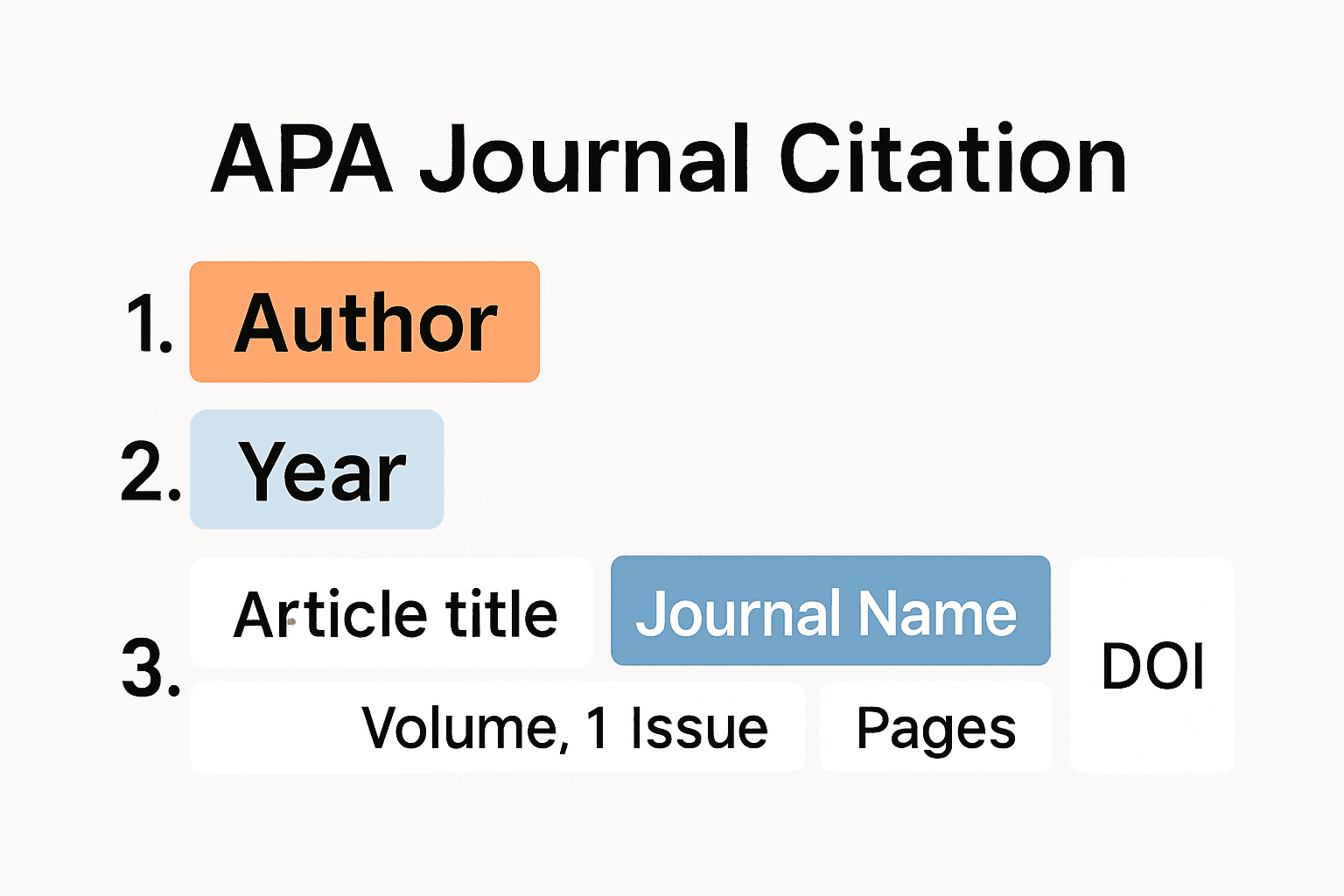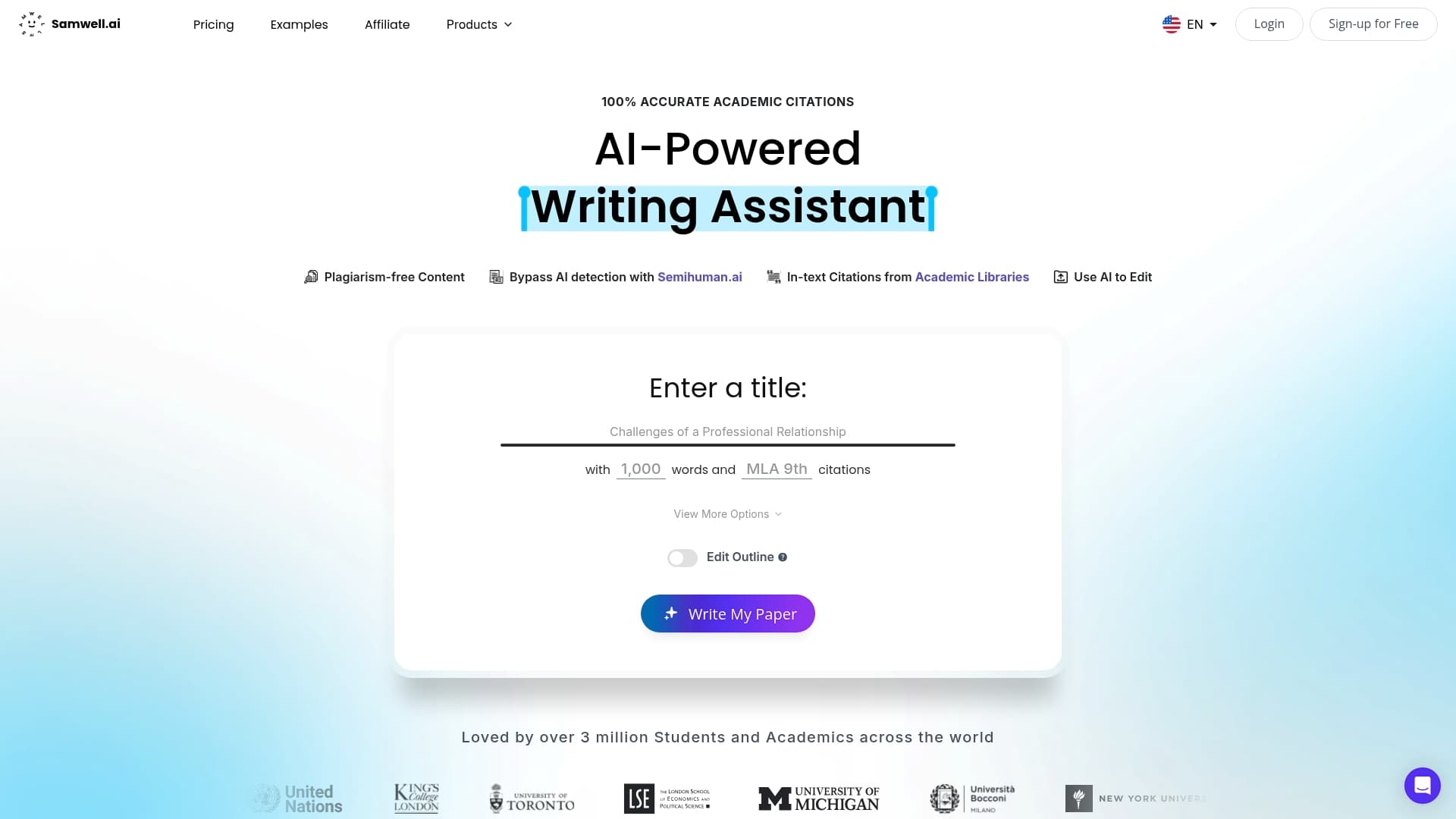Blog
Learning Materials
How to APA Cite Academic Journal Articles in 2025
Updated: July 9, 2025

APA citations for academic journals can seem tedious and overwhelming, especially with constant updates to official guidelines. Here is a twist. Over 70 percent of student writers make errors in APA references every semester, and many never realize it. The real shock is that most mistakes are simple and easy to fix if you know a few insider tricks, making proper citations less stressful than you think.
Table of Contents
- Apa Citation Basics For Academic Journals Dockerfile README.md email-templates i18n-config.ts i18nConfig.ts next-sitemap-samwell.config.js next-sitemap-semihuman.config.js next.config.js node_modules package-lock.json package.json process_content.js public scripts src svgr.d.ts translations tsconfig.json Core Components Of Journal Article Citations Dockerfile README.md email-templates i18n-config.ts i18nConfig.ts next-sitemap-samwell.config.js next-sitemap-semihuman.config.js next.config.js node_modules package-lock.json package.json process_content.js public scripts src svgr.d.ts translations tsconfig.json Formatting Specific Citation Elements
- Step-By-Step Guide To Citing Journal Articles Dockerfile README.md email-templates i18n-config.ts i18nConfig.ts next-sitemap-samwell.config.js next-sitemap-semihuman.config.js next.config.js node_modules package-lock.json package.json process_content.js public scripts src svgr.d.ts translations tsconfig.json Gathering Essential Citation Information Dockerfile README.md email-templates i18n-config.ts i18nConfig.ts next-sitemap-samwell.config.js next-sitemap-semihuman.config.js next.config.js node_modules package-lock.json package.json process_content.js public scripts src svgr.d.ts translations tsconfig.json Constructing The Reference Entry
- Common Apa Citation Mistakes To Avoid Dockerfile README.md email-templates i18n-config.ts i18nConfig.ts next-sitemap-samwell.config.js next-sitemap-semihuman.config.js next.config.js node_modules package-lock.json package.json process_content.js public scripts src svgr.d.ts translations tsconfig.json Formatting And Structural Errors Dockerfile README.md email-templates i18n-config.ts i18nConfig.ts next-sitemap-samwell.config.js next-sitemap-semihuman.config.js next.config.js node_modules package-lock.json package.json process_content.js public scripts src svgr.d.ts translations tsconfig.json Digital Source Citation Challenges
- Useful Tools For Apa Journal Citations Dockerfile README.md email-templates i18n-config.ts i18nConfig.ts next-sitemap-samwell.config.js next-sitemap-semihuman.config.js next.config.js node_modules package-lock.json package.json process_content.js public scripts src svgr.d.ts translations tsconfig.json Reference Management Software Dockerfile README.md email-templates i18n-config.ts i18nConfig.ts next-sitemap-samwell.config.js next-sitemap-semihuman.config.js next.config.js node_modules package-lock.json package.json process_content.js public scripts src svgr.d.ts translations tsconfig.json Online Citation Generators Dockerfile README.md email-templates i18n-config.ts i18nConfig.ts next-sitemap-samwell.config.js next-sitemap-semihuman.config.js next.config.js node_modules package-lock.json package.json process_content.js public scripts src svgr.d.ts translations tsconfig.json Browser And Word Processor Extensions
Quick Summary
| Takeaway | Explanation |
|---|---|
| Core Components of APA Citations | A complete APA citation for journal articles includes the author's last name, initials, publication year, article title, journal name, volume number, issue number, and page range or DOI. |
| Gathering Citation Information | Before creating citations, compile essential elements like author names, publication year, and article or journal specifics to prevent errors. |
| Common Citation Mistakes | Avoid frequent pitfalls such as improper title capitalization and inconsistent formatting between in-text citations and reference lists to uphold academic integrity. |
| Utilizing Citation Tools | Leverage reference management software, online citation generators, and browser extensions to streamline citation processes and ensure formatting accuracy. |
APA Citation Basics for Academic Journals
Academic journal citations in APA format require precision and attention to specific details that ensure proper academic recognition and intellectual transparency. Understanding these fundamental principles helps researchers communicate their sources accurately and professionally.
Core Components of Journal Article Citations
APA citation for academic journals involves several critical elements that create a standardized reference. At its core, a complete journal article citation includes the author's last name, initials, publication year, article title, journal name, volume number, issue number, and page range or digital object identifier (DOI).

The most recent APA 7th edition introduced several nuanced changes that researchers must understand. For instance, learn more about modern citation techniques to ensure your references meet current academic standards. Authors must now include the DOI as a hyperlink when available, which provides a persistent way to locate the original source.
Formatting Specific Citation Elements
When citing journal articles, specific formatting rules apply. According to research from Monash University, articles with multiple authors require careful attention. For publications with 21 or more authors, researchers should list the first 19 names, insert an ellipsis, and then list the final author's name. This approach maintains comprehensive attribution while preventing overly lengthy references.
Digital publications have unique considerations. When referencing an article with an article number instead of traditional page numbers, researchers must include the word "Article" followed by the specific article number. For advance online publications, the citation should indicate "Advance online publication" and include the DOI or URL.
Professional researchers recognize that accurate citations are more than technical requirements. They represent intellectual honesty, allowing readers to trace the origins of ideas, validate research claims, and engage with the broader academic conversation. By mastering these citation basics, scholars demonstrate rigor and respect for the collective knowledge-building process in their respective fields.
Accurate APA citations serve multiple purposes: they provide credibility to research, enable knowledge traceability, and give proper recognition to original authors. Understanding these foundational principles ensures that your academic writing meets the highest standards of scholarly communication.
Step-by-Step Guide to Citing Journal Articles
Citing academic journal articles requires a systematic approach that ensures accuracy and adherence to APA guidelines. This comprehensive guide will walk you through the precise process of creating a professional citation that meets scholarly standards.
Gathering Essential Citation Information
Before beginning your citation, collect all critical information from the journal article. According to Simon Fraser University's citation guide, you will need to compile the following key elements:
- Author's full name(s)
- Publication year
- Complete article title
- Full journal name
- Volume number
- Issue number (if applicable)
- Page range or article number
- Digital Object Identifier (DOI) or URL
Professional researchers understand that meticulous preparation prevents citation errors. Explore advanced citation techniques to streamline your academic writing process and ensure precision.
Constructing the Reference Entry
The APA 7th edition provides specific formatting guidelines for creating reference entries. According to Victoria University's referencing guide, the standard format follows this structure:
Author Last Name, First Initial. (Year of Publication). Article Title. Journal Name, Volume Number(Issue Number), Page Range. https://doi.org/xxxxx
For digital publications without traditional page numbers, include the article number preceded by the word "Article". When an advance online publication lacks complete publication information, use "Advance online publication" and include the DOI or URL.
Key considerations for different scenarios include:
- Single author articles
- Multiple author publications
- Online-only journals
- Articles with digital object identifiers
Researchers must pay careful attention to formatting details. Italicize the journal name and volume number, use sentence case for the article title, and ensure consistent punctuation throughout the reference.
The citation process goes beyond mere technical compliance. It represents a critical component of academic integrity, providing readers with a clear path to verify and explore the original research. By mastering these citation techniques, you demonstrate scholarly rigor and respect for intellectual contributions across academic disciplines.
To help you quickly grasp the variations in APA citation formatting for different types of journal articles, here's a summary table highlighting the key differences and required elements in each scenario:
| Scenario | Required Elements | Notable Formatting Rules |
|---|---|---|
| Single Author Article | Author's name, year, title, journal name, volume, (issue), pages or DOI | Italicize journal name & volume, sentence case for title |
| Multiple Authors (<21) | All authors' names, year, title, journal name, volume, (issue), pages or DOI | List all authors, use ampersand before last name |
| Multiple Authors (21+) | First 19 authors, ellipsis (...), last author, year, title, journal, volume, (issue) | Insert ellipsis after 19th author, list last author only |
| Article with Article Number | Author(s), year, title, journal name, volume, (issue), Article [number], DOI | Use "Article" before number instead of page range |
| Advance Online Publication | Author(s), year, title, journal name, (if available), Advance online publication, DOI | Note "Advance online publication"; include DOI or URL |
Common APA Citation Mistakes to Avoid
Academic writing demands precision, and APA citations are no exception. Researchers frequently encounter pitfalls that can compromise the credibility of their scholarly work. Understanding and avoiding these common errors is crucial for maintaining academic integrity and professional standards.
Formatting and Structural Errors
One of the most prevalent citation mistakes involves improper formatting and structural inconsistencies. According to Alvernia University's citation guide, researchers often make critical errors in title capitalization. Learn more about precise citation techniques to ensure your references meet the highest academic standards.
In APA 7th edition, only the first word of the title, the first word after a colon, and proper nouns should be capitalized. Many researchers mistakenly capitalize every word, which directly violates APA guidelines. For example, the title "The impact of climate change on marine ecosystems" should not have every word capitalized.
Another frequent mistake involves inconsistent formatting between in-text citations and the reference list. According to Purdue Global Writing Center, researchers must ensure that every in-text citation precisely matches its corresponding reference list entry, with identical author names and publication years.
To help you avoid the most common APA citation mistakes, the following table summarizes key errors and the best practices to correct them:
| Common Mistake | Explanation/Example | Best Practice |
|---|---|---|
| Over-capitalizing Article Titles | Capitalizing Every Word in the Title (e.g., "Climate Change Impacts") | Use sentence case; only the first word & proper nouns are capitalized |
| Inconsistent In-text vs. Reference List | Author names/dates differ between text and list | Double-check author names and years for consistency |
| Missing DOI or URL for Digital Sources | Omitting required DOI of an online article | Always include DOI as hyperlink if available |
| Mishandling Multiple Author Citations | Listing all authors for articles with 21+ authors | List first 19, then ellipsis, then final author |
| Not Noting Advance Online Publication | Forgetting to add "Advance online publication" for pre-publication articles | Add "Advance online publication" and the DOI/URL |
Digital Source Citation Challenges

Digital publications present unique citation challenges that often trip up even experienced researchers. The most critical error involves mishandling Digital Object Identifiers (DOIs). As recommended by academic citation experts, when a DOI is available, it must be included in the reference entry. For online sources without a DOI, researchers should provide the publisher's URL.
Multiple-author publications require careful attention. When a journal article has more than 20 authors, researchers must list the first 19 authors, use an ellipsis, and then list the final author's name. This approach maintains comprehensive attribution while preventing excessively long references.
Advance online publications demand special notation. Citations for these sources should include "Advance online publication" and the specific DOI or URL. Many researchers overlook these nuanced requirements, potentially compromising the accuracy of their citations.
Professional researchers recognize that citation errors are more than mere technical mistakes. They represent potential breaches of academic integrity. Each citation serves as a critical link in the scholarly conversation, allowing readers to trace the origins of ideas, validate research claims, and engage with the broader academic discourse.
By understanding and avoiding these common citation mistakes, researchers demonstrate their commitment to scholarly precision. Accurate citations are not just about following rules they are about respecting intellectual contributions and maintaining the highest standards of academic communication. Careful attention to detail ensures that your research stands up to the most rigorous academic scrutiny.
Useful Tools for APA Journal Citations
Navigating the complex world of academic citations requires sophisticated tools that streamline the research and referencing process. Modern researchers have access to powerful digital solutions that simplify APA journal citations, ensuring accuracy and saving valuable time.
Reference Management Software
Reference management software has revolutionized academic writing and citation processes. Explore advanced citation techniques to maximize your research efficiency. According to Wikipedia's technology overview, tools like Zotero offer comprehensive citation management capabilities.
Key reference management tools include:
- Zotero: A free, open-source reference management tool that integrates seamlessly with web browsers. It allows researchers to collect, organize, and cite research materials automatically.
- Mendeley: An advanced reference manager that combines citation management with academic networking features.
- JabRef: An open-source citation software supporting multiple research databases and citation formats.
To help compare the top reference management tools mentioned, the following table summarizes their core features and strengths:
| Tool | Cost | Notable Features | Integration |
|---|---|---|---|
| Zotero | Free | Open-source, browser integration, automatic citation | Web browsers, Word, Google Docs |
| Mendeley | Free* | Citation management, academic networking | Word, PDF annotation |
| JabRef | Free | Open-source, BibTeX/LaTeX support | Research databases |
*Note: Mendeley offers additional paid features.
Online Citation Generators
Online citation generators provide quick and reliable solutions for researchers struggling with complex APA formatting requirements. These web-based tools automatically generate correctly formatted citations by parsing article information. Researchers can simply input article details, and the generator produces perfectly structured references.
Top online citation generators offer features like:
- Instant APA 7th edition formatting
- Support for multiple publication types
- Direct integration with research databases
- Export options for various document formats
Browser and Word Processor Extensions
Modern citation tools extend beyond standalone software. Browser extensions and word processor plugins enable researchers to capture citation information directly from academic websites and insert references with minimal manual intervention.
These extensions typically provide:
- One-click citation capture
- Automatic bibliography generation
- Seamless integration with popular writing platforms
- Real-time formatting checks
Researchers must select tools that align with their specific workflow and institutional requirements. While these technologies significantly reduce citation-related stress, they are not infallible. Always double-check generated citations against official APA guidelines to ensure absolute accuracy.
The landscape of citation tools continues to evolve, with artificial intelligence and machine learning promising even more sophisticated solutions in the coming years. By leveraging these advanced technologies, researchers can focus more on their intellectual contributions and less on technical formatting challenges.
Frequently Asked Questions
What are the core components of an APA citation for academic journal articles?
A complete APA citation includes the author's last name, initials, publication year, article title, journal name, volume number, issue number, and page range or DOI.
How do I format multiple authors in an APA citation?
For articles with 21 or more authors, list the first 19 authors, insert an ellipsis, and then include the last author's name. For works with fewer than 21 authors, list all authors' names in the citation.
What should I do if my journal article doesn't have traditional page numbers?
If an article has an article number instead of page numbers, include the word "Article" followed by the article number in the citation. If it's an advance online publication, note it as "Advance online publication" and include the DOI or URL.
What common mistakes should I avoid when formatting APA citations?
Avoid over-capitalizing titles, ensuring consistent formatting between in-text citations and the reference list, and always including a DOI for digital sources when available.
Eliminate APA Stress: Let Samwell.ai Perfect Your Citations
Struggling with APA journal citations can make even the most confident writers feel overwhelmed. If you worry about small mistakes costing you points, missed DOIs, or confusing author formats, you are not alone. The article above highlights how tricky it is to keep up with evolving citation rules and how common errors in formatting and digital references can quickly derail your hard work.

Why keep risking errors when a smarter solution is available right now? Samwell.ai is designed to remove citation guesswork entirely. Our advanced platform helps you generate, review, and perfect APA references in seconds. Let our Semihuman.ai technology ensure every reference is accurate and original so you can focus on your research instead of citation formatting. Ready to take control and avoid common citation pitfalls discussed in this guide? Start building error-free references with Samwell.ai or discover more ways we support academic excellence in our APA citation research paper guide.
Recommended
Generate essays with Samwell.ai
Whether you’re a publisher, professor, journalist, or student, let us tailor a plan just for you.Most Read Articles

Your Guide to Help Writing a Essay Successfully
Expert tips for help writing a essay - from crafting a thesis to structuring your essay effectively.

How to Write Critical Thinking Essay: Expert Tips
Expert tips for writing a critical thinking essay. Learn how to structure, choose topics, and use evidence effectively.'

How to Write a Good Hook: A Step-by-Step Guide
Master the art of crafting a good hook with our guide. Create compelling openers for a memorable first impression.
